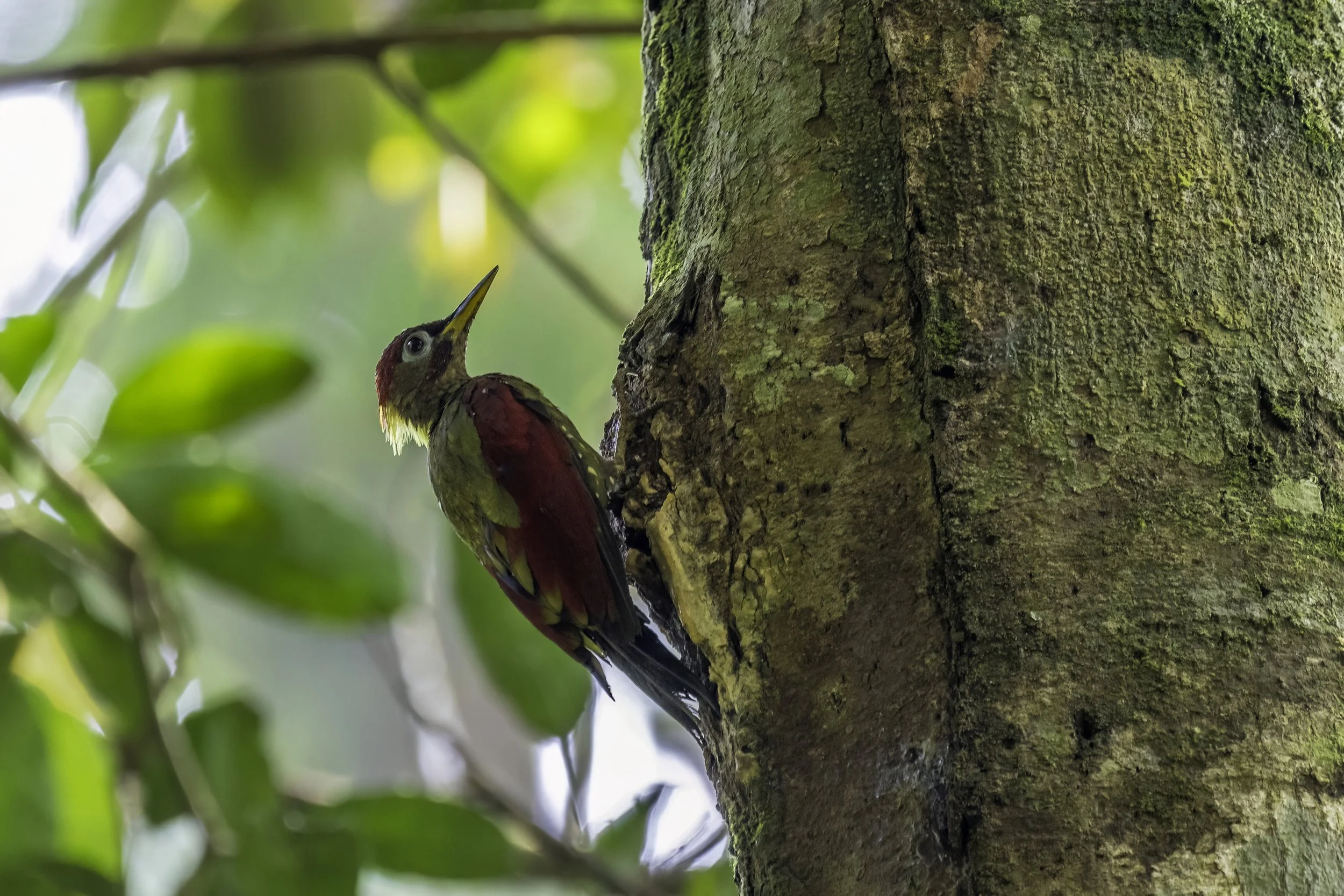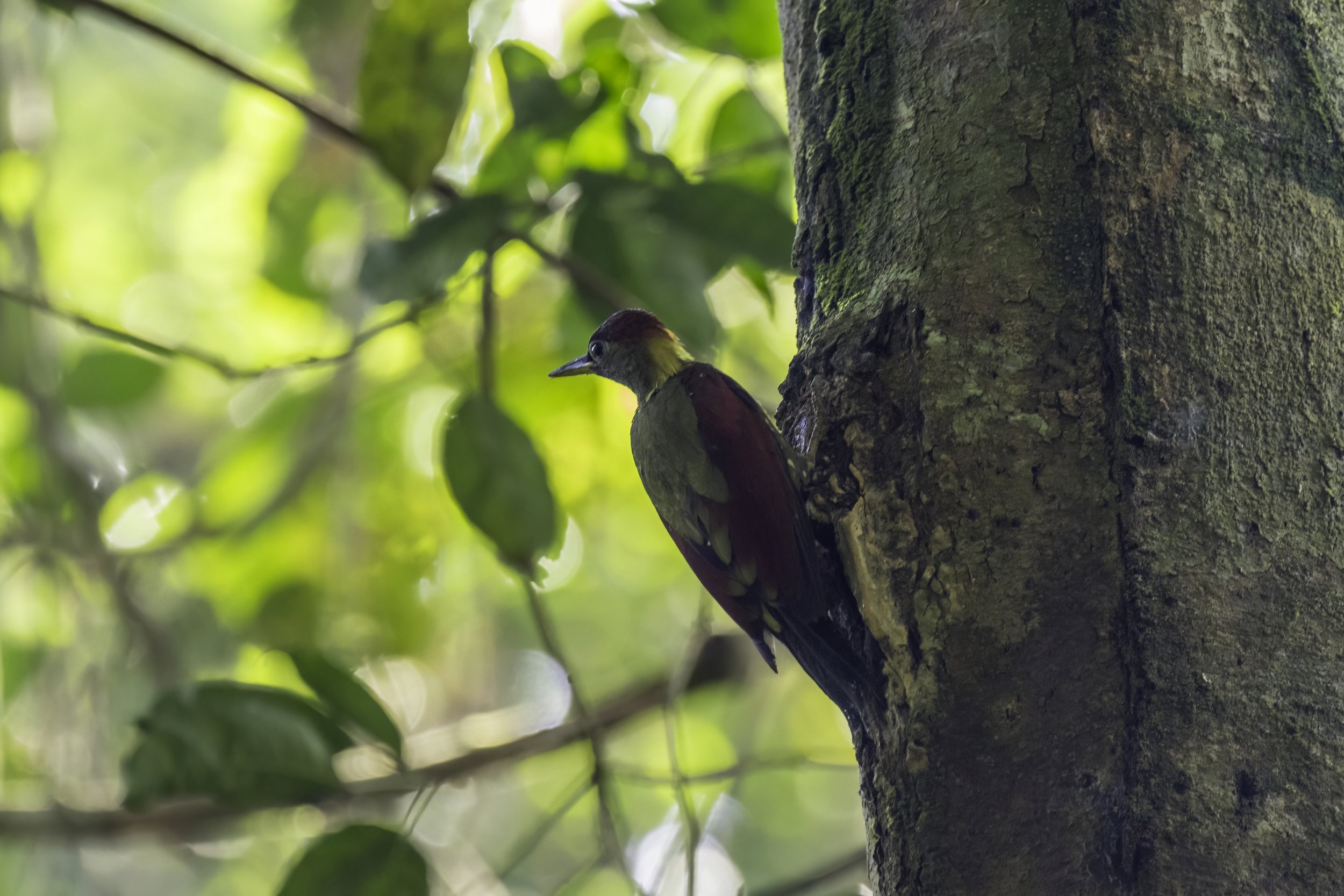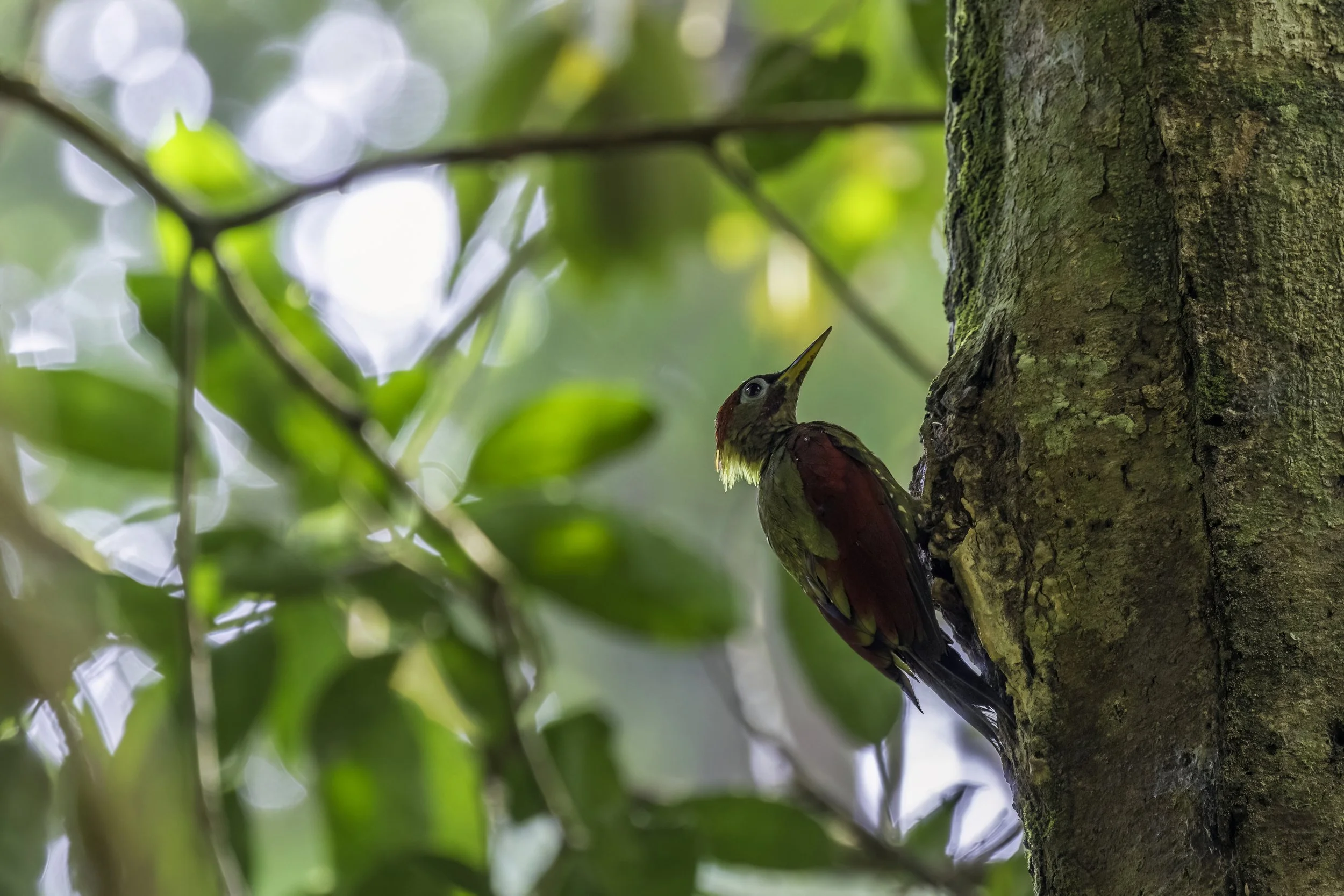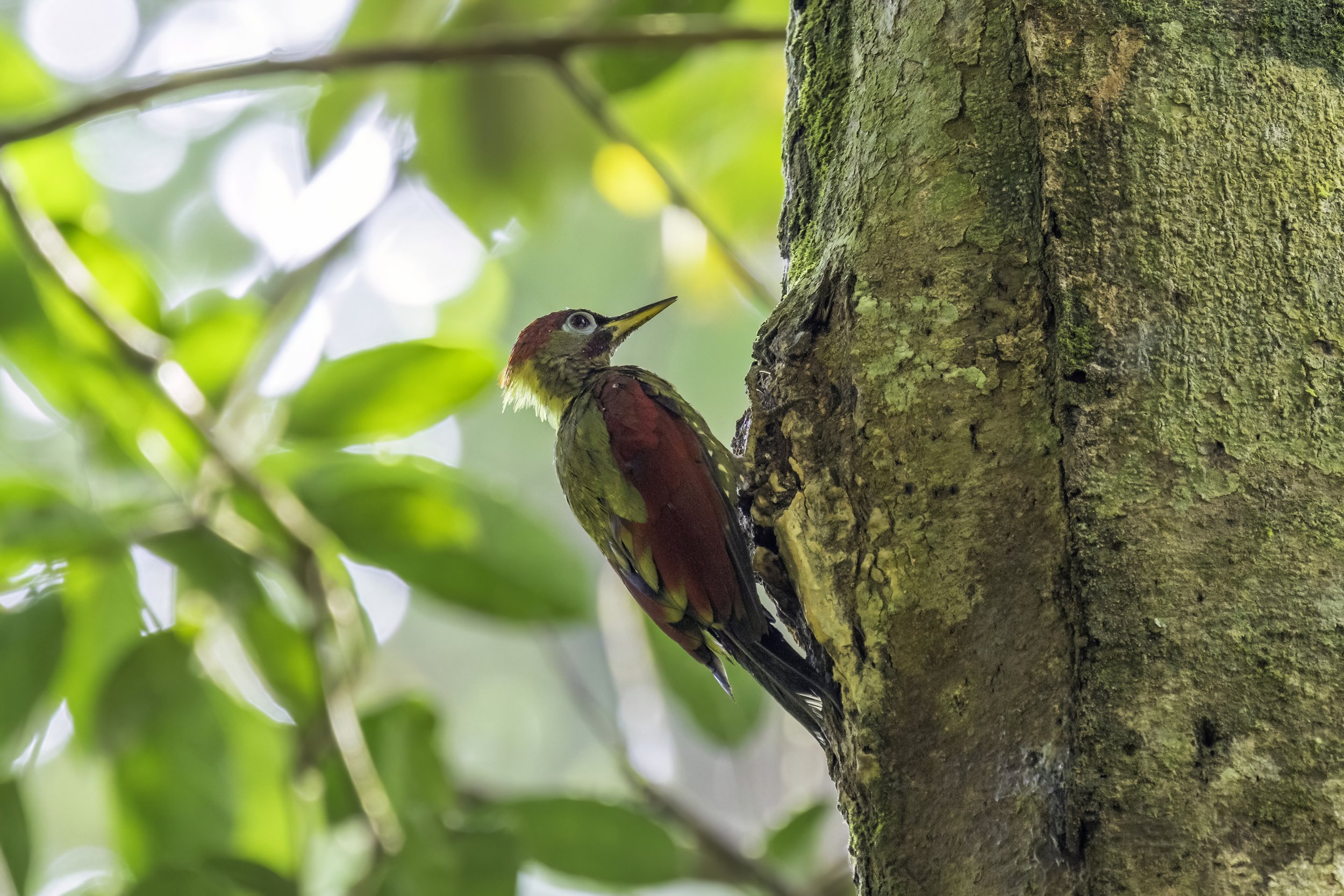Crimson-winged Woodpecker
Picus puniceus
Sungai Congkak, Malaysia
Woodpeckers, as their name suggests, are chiefly known for their characteristic behaviour, foraging for insect prey on the trunks and branches of trees, and often communicating by drumming with their beaks, producing a reverberatory sound that can be heard at some distance. Some species vary their diet with fruits, birds' eggs, small animals, tree sap, human scraps, and carrion. They usually nest and roost in holes that they excavate in tree trunks, and their abandoned holes are of importance to other cavity-nesting birds. They sometimes come into conflict with humans when they make holes in buildings or feed on fruit crops, but perform a useful service by their removal of insect pests on trees.. They are part of the bird family Picidae, which also includes the piculets, wrynecks and sapsuckers. Members of this family are found worldwide, except for Australia, New Guinea, New Zealand, Madagascar and the extreme polar regions. Most species live in forests or woodland habitats, although a few species are known that live in treeless areas, such as rocky hillsides and deserts, and the Gila woodpecker specialises in exploiting cacti.
The Picidae are one of nine living families in the order Piciformes, the others being barbets (comprising three families), toucans, toucan-barbets, and honeyguides, which (along with woodpeckers) comprise the clade Pici, and the jacamars and puffbirds in the clade Galbuli. DNA sequencing has confirmed the sister relationships of these two groups. The family Picidae includes about 240 species arranged in 35 genera. Almost 20 species are threatened with extinction due to loss of habitat or habitat fragmentation, with one, the Bermuda flicker, being extinct and a further two possibly being so.
The plumage of woodpeckers varies from drab to conspicuous. The colours of many species are based on olive and brown and some are pied, suggesting a need for camouflage; others are boldly patterned in black, white, and red, and many have a crest or tufted feathers on their crowns. Woodpeckers tend to be sexually dimorphic, but differences between the sexes are generally small; exceptions to this are Williamson's sapsucker and the orange-backed woodpecker, which differ markedly. The plumage is moulted fully once a year apart from the wrynecks, which have an additional partial moult before breeding.
Woodpeckers, piculets, and wrynecks all possess characteristic zygodactyl feet, consisting of four toes, the first (hallux) and the fourth facing backward and the second and third facing forward. This foot arrangement is good for grasping the limbs and trunks of trees. Members of this family can walk vertically up tree trunks, which is beneficial for activities such as foraging for food or nest excavation. In addition to their strong claws and feet, woodpeckers have short, strong legs. This is typical of birds that regularly forage on trunks. Exceptions are the black-backed woodpecker and the American and Eurasian three-toed woodpeckers, which have only three toes on each foot. The tails of all woodpeckers, except the piculets and wrynecks, are stiffened, and when the bird perches on a vertical surface, the tail and feet work together to support it.
Woodpeckers have strong bills that they use for drilling and drumming on trees, and long, sticky tongues for extracting food (insects and larvae). Woodpecker bills are typically longer, sharper, and stronger than the bills of piculets and wrynecks, but their morphology is very similar. The bill's chisel-like tip is kept sharp by the pecking action in birds that regularly use it on wood. The beak consists of three layers; an outer sheath called rhamphotheca, made of scales formed from keratin proteins, an inner layer of bone which has a large cavity and mineralised collagen fibers, and a middle layer made of porous bone which connects the two other layers.
Woodpeckers have a mostly cosmopolitan distribution, although they are absent from Australasia, Madagascar, and Antarctica. They are also absent from some of the world's oceanic islands, although many insular species are found on continental islands. The true woodpeckers, subfamily Picinae, are distributed across the entire range of the family. The Picumninae piculets have a pantropical distribution, with species in Southeast Asia, Africa, and the Neotropics, with the greatest diversity being in South America. The second piculet subfamily, the Sasiinae, contains the African piculet and two species in the genus Sasia that are found in Southeast Asia. The wrynecks (Jynginae) are found exclusively in the Old World, with the two species occurring in Europe, Asia, and Africa.
Read about the other woodpeckers I have already written about.
Sungai Congkak
About 35 kilometres from both Kuala Lumpur city center and Selangor’s Kajang town, lies the Sungai Congkak Recreational Forest, or Hutan Lipur Sungai Congkak. Also known as Chongkak Park & Resort, it is s a popular recreational forest in the Hulu Langat district of Selangor state and is managed by Tourism Selangor.
A dipterocarp rainforest that is part of the great Titiwangsa mountain range, Sungai Congkak Recreational Forest is rich in flora and fauna with meandering, crystal-clear rivers. Nestled in a cool and hilly area of Hulu Langat, the route leading to the forest passes through quaint towns and villages where the pace of life is noticeably slower.
Slightly deeper into Sungai Congkak Recreational Forest is the starting point of a challenging hiking trail to Bukit Chenuang (Chenuang Hill) which takes about an hour. Reaching an altitude of about 850 meters, the peak here provides great views of the surrounding valley. From Bukit Chenuang, one can continue hiking the trail to Bukit Batu Kumbang, which is about an hour away. The views of the Titiwangsa mountain range from the peak of Bukit Batu Kumbang make it a worthwhile hike.
Crimson-winged Woodpecker
The Crimson-winged Woodpecker (Picus puniceus) is a bright and colourful bird that is hard to misidentify in the woodpecker family. It is found in Brunei, Indonesia, Malaysia, Myanmar, Singapore, and Thailand. Its natural habitat is subtropical or tropical moist lowland forests. It can grow up to 25 cm long. Its diet is mainly insects and larvae.
It is a greenish medium-sized woodpecker with bright red wings, crown & a striking yellow crest, cream-speckled sides, and pale blue-gray “spectacles”. The male has a greener face than the female, and has a maroon “mustache” stripe. It is similar to the Checker-throated and Banded Woodpeckers, but can be differentiated by their red crown and greenish body. They inhabit both primary and secondary forests, from lowlands into lower montane areas, as well as plantations and logged tracts, favouring areas with scattered and isolated tall trees. They can be spotted foraging on trunks and large branches in the upper story, often in distanced pairs or mixed flocks. Their call is a high-pitched “kee-dee”, with the second note often being repeated several times, occasionally with a descending quality.
The Crimson-winged is about 25cm long and weighs between 66-96 grams. The juveniles are duller than the adults, with more extensive markings below. The red of the head is normally confined to the rear and side of the crown.
Their habitat is evergreen primary and secondary forest with scattered tall trees, forest edges, secondary growth, and plantations. They are known to occasionally visit coastal scrub and gardens in Sumatra and Java. They are also found in the lowlands to 900 m; below 600 m in Thailand; to 1300 m in Peninsular Malaysia (Fraser’s Hill); perhaps to 1500 m in Borneo. Generally replaced by P. chlorolophus at higher elevations.
Their main diet comprises of ants and termites including their eggs and grubs. They forage singly, but mainly in pairs, partners keeping contact at moderate distances and they regularly join mixed-species flocks. They favour tall trees, particularly emergent forest trees, even those in lower second growth or free-standing foraging mainly in the canopy, on trunks and major branches. They explore bark, as you can see in these photos, especially where lichens present, and crevices; hammering in short bursts, frequently in hard live wood, and probes, gleans, and removes pieces of bark. They moves rather systematically, rarely spending much time at a single spot.
The Crimson-winged Woodpecker is not globally threatened and is common to fairly common throughout its range. It is one of the most frequently encountered woodpeckers in the Malaysian rainforest which is where I encountered it. It is extinct in Singapore although I have heard birders say they have seen it.
Now let’s get on to the images of this woodpecker which appeared for a brief interval on a nearby tree.
Related Posts




















